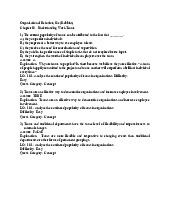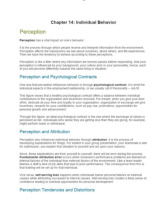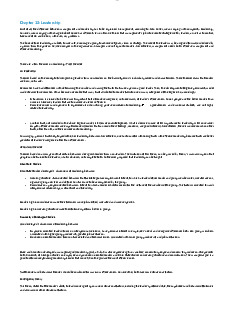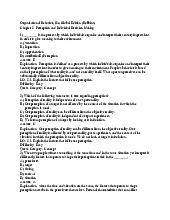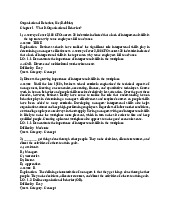










Preview text:
VIETNAM NATIONAL UNIVERSITY HCMC INTERNATIONAL UNIVERSITY School of Business COURSE SYLLABUS
Course Name: Organizational Behavior BA130IU
1. General information Course
The course is organized around three determinants of behavior in organizations: 1) designation
individuals, 2) groups/teams, and 3) organizational structure. Particular emphasis will
be placed on individual difference, attitude, motivation, job satisfaction,
communication, leadership, stress, change, and organizational culture. Vigorous class
discussions, presentations, cases, activities, along with group projects and self quizzes
will provide the basis for the learning environment in the classroom. Semesters in 1, 2 which the course is taught
Person responsible Nguyen Tan Minh (Mr.) for the course Office: O1.307 Phone number: 0942 556 009 E-mail: ntminh@hcmiu.edu.vn Language English Compulsory Relation to curriculum Teaching methods Lecture, lesson, quiz Workload (incl.
(Estimated) Total workload: 135 contact hours,
Contact hours (please specify whether lecture, exercise, laboratory session, etc.): 45 selfstudy hours)
Private study including examination preparation, specified in hours1: 90 Credit points 3 Required and None recommended prerequisites for joining the course Course
After taking this class, the students should all be able: objectives -
To demonstrate an understanding of the effects that individuals and groups
have on organizations and apply that understanding to the solving organizational problems. -
To demonstrate an understanding of the theories and concepts of individual,
group and organizational behavior as they apply to organizational decision-making. -
To apply concepts and theories about individual style and perception to solving organizational problems. -
To apply theories of motivation to the management of organizations. -
To use systematic problem-solving approaches in developing solutions to organizational problems. -
To exhibit clear and concise written reports and oral presentations skills to
communicate understanding and application of theories, topics and concepts. -
To effectively participate individually, and as a member of small and large
teams, in the completion of all course assignments.
1 When calculating contact time, each contact hour is counted as a full hour because the organization of the schedule, moving from room to room, and individual questions
to lecturers after the class, all mean that about 60 minutes should be counted. Course learning
Upon the successful completion After completing the course, students should have outcomes developed skills in: Competency Course learning outcome (CLO) level Knowledge
LO1. Compare the effects of various
psychological factors on individual behavior
LO2. Examine major inter-personal forces that
alter human behaviors in team/group context in oral form. (Discuss)
LO3. Classify the potential effects of
organizational-level factors (such as structure,
culture and change) on organizational behavior Skill
LO4. Apply a motivational theory to a realistic
motivational problem in an organizational context;
provide management recommendations consistent with theory. Attitude
LO5. Solve typical organizational-level issues to
achieve overall organizational success in the context of
cultural diversity and global sustainability. Content
This course is designed to give students the basic knowledge of human behavior in
organizations and how to apply this knowledge to increase the organization effectiveness. Examination forms Multiple-choice questions Study and
In order to pass this course, the students must: examination requirements
− achieve a composite mark of at least 50;
− attend at least 80 percent of the total sessions of the course;
− make a satisfactory attempt at all assessment tasks (see below). Reading list Textbook
[ ]1 ∙ Robbins, S. P. and Judge, T. A. (2018), Essentials of Organizational
Behavior, 18th edition, Pearson Education. Reference book:
[ ]2 ∙ John W. Newstrom, (2014), Organizational Behavior-Human
Behavior at Work, 14th edition, International Edition, McGraw Hill.
[ ]3 ∙ Hellrigel, D., Slocum, J., & Woodman (2010), Organizational
Behavior, 13th edition, Thomson-South Western. − Additional material
The instructor will provide his/her lecture notes and additional reading
available on Blackboard. However, this is not an automatic entitlement for
students doing this subject. Note that this is not a distance-learning course,
and the students are expected to attend lectures and take notes.
2. Learning Outcomes Matrix P LO CLO 1 2 3 4 5 6 1 x 2 x x 3 x x 4 x x 5 x x
3. Planned learning activities and teaching methods Week Topic CLO Assessment Learning Resource activities 1 Chapter 1: What is 1 Lecture [1] Organizational Behavior 2 Chapter 2: Diversity in 1 Lecture [1] Organizations Chapter 3: Attitudes and Job Satisfaction 3 Chapter 4: Personality and 1 Lecture [1] Values 4 Chapter 5: Perception and 1 Lecture [1] Individual Decision Making 5 Chapter 6: Emotions and 1 Lecture [1] Moods 6 Chapter 7: Motivation 1,4 Lecture [1] Concepts 7 Chapter 8: Motivation: From 1,4 Quiz 1 Lecture [1] Concepts to Applications 8 Chapter 9: Foundations of 1 Lecture [1] Group Behavior Mid-term exam 1,4 MCQ exam 9 Chapter 10: Understand 2 Lecture [1] Work Teams 10 Chapter 11: Power and 2,5 Lecture [1] Politics 11 Chapter 13: Leadership 2,5 Lecture [1] 12 Chapter 14: Foundations of 3 Lecture [1] Organization Structure 13 Chapter 15: Organizational 3,5 Quiz 2 Lecture [1] Culture 14 Chapter 17: Organizational 3,5 Lecture [1] Change and Stress Management 50% 50% Midterm exam (30%) Pass Pass 50% 50% 50% Final exam (40%) Pass Pass Pass 15 Chapter 18: Conflict and 3,5 Lecture [1] Negotiation Final exam 2,3,5 MCQ exam 4. Assessment plan LEARNING ASSESSMENT Assessment Type CLO1 CLO2 CLO3 CLO4 CLO5 Quizzes
GRADING RUBRIC FOR WRITTEN COURSEWORK (30%) 50%Pass 50%Pass 50%Pass 50%Pass 50%Pass ADEQUATE ABOVE AVERAGE GOOD EXEMPLARY Criteria INADEQUATE 10% – 49% 50% - 59% 60% - 69% 70% - 84% ≥ 85% Organization Does not organize Generally organized Clear organization and Response is focused, and clarification ideas logically logically, with evidence of progression. detailed and non-tangential. and with progression clarification. Responds appropriately Shows a high degree of Occasionally, there may and relevantly, although attention to logic and Limited evidence be a lack of focus or ideas some ideas are reasoning of points. of coherence may be tangential underdeveloped. Clearly leads the reader to Ideas lack the conclusion and stirs consistence thought regarding the topic Originality and Demonstrates an Shows ability to identify Shows strong ability to Shows strong ability to usefulness of the incomplete grasp issues, gather the facts identify issues, gather the identify issues, gather the analysis of the task. and develop claims. facts and develop claims facts and develop claims as as well as link claims well as link claims with There is no Arguments are addressed with evidence. evidence. overall sense of well but no links with creative evidence Overall, an acceptable Satisfactory solutions are coherence. solution is offered and offered and supported explained Arguments are addressed incompletely. Use of Shows little Shows moderate amount Draws upon sources to Draws upon primary and data/information information from of source information support most points. secondary source sources. Poor incorporated. information in useful and Some evidence may not handling of illuminating ways to support Some key points support arguments or may sources key points. supported by sources. appear where inappropriate. Excellent integration of Quotations may be poorly quoted material into integrated into Quotations integrated paragraphs. well into paragraphs. paragraphs. Source cited correctly Some possible problems Sources cited correctly with source citations Use of Shows limited Shows effort to link Shows ability to structure Shows ability to structure frameworks ability to structure problems with the problems in problems in correspondence problems in theoretical frameworks. correspondence to to theoretical frameworks correspondence to theoretical frameworks correctly. theoretical There are still some correctly. frameworks mistakes The problems are well Minor mistakes in resolved resolving problems Quality of Shows little Shows argument of poor Shows clear, relevant and Shows identifiable, arguments attempt to offer quality. logical arguments. reasonable and sound support for key arguments. claims or to relate Weak, undeveloped evidence to reasons are offered to Clear reasons are offered to analysis. support key claims support key claims. The reasons offered are irrelevant.
Ho Chi Minh City, 30/08/2024
